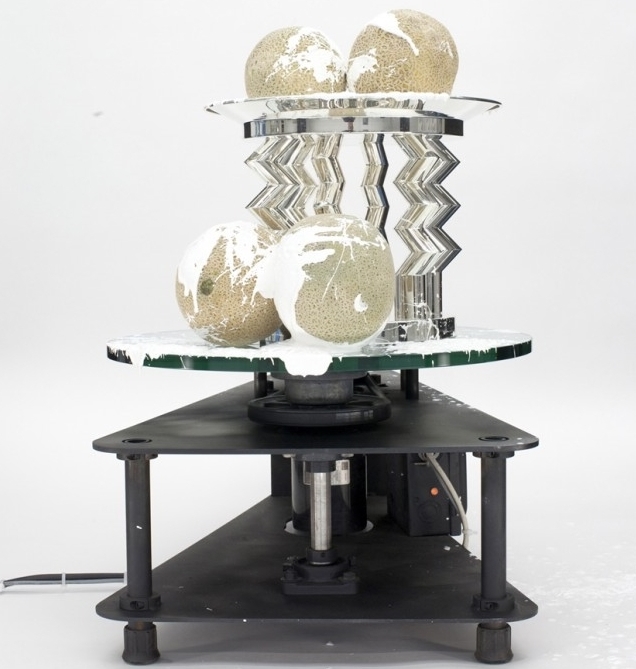Justin Beal
"Love from Ettore," Justin Beal: Listeria, LA><ART Exhibition Handbook No. 3, 2013: 47–53.
Murmansk is a Soviet light cruiser: 17,000 tons of corroding warship, sold for scrap and then stranded off the coast of Norway. Murmansk is a Russian port city: the largest on the arctic coast, presided over by a 116-foot-tall concrete soldier. Murmansk is also a fruit dish, held aloft by six tubular legs crimped like a scissor-lift: cold, implacable, silver. Designed in 1982, six months after Ettore Sottsass and the other members of Memphis made their debut, Murmansk seems to turn away from the radically provisional furniture and the swaggering merchandizing of that that first exhibition. Sottsass's fruit dish funnels the ancient tazza through industrial pipelines and automobile chrome, through Brancusi’s gleaming bronzes and Man Ray’s silver chess pieces, through Chaplin’s and Warhol’s factories. Yet it appears to end up where it started: as a luxury product made in spite of, or even against, Memphis itself.
Produced by the Vicenza-based silversmith Rossi e Arcandi, Murmansk was one of several Memphis silvers released that year. While the group's first exhibition included lamps and ceramics among the furniture pieces, the bourgeois appurtenances of their sophomore effort made those initial items look positively utilitarian. Peter Shire designed a teapot, Daniela Puppa and Nathalie du Pasquier, a pair of serving trays, Andrea Branzi, a cone-shaped sauceboat cradled in a silver twig. All the designers gave their works northerly names: Anchorage, Reykjavik, Labrador—polar zones for frigid material. These were remote cities, far from the industrial terms and communicative networks sought out by the group. For Memphis, wrote Barbara Radice in their 1984 monograph-manifesto, “an object exists as a system of signs, as a catalyst of emotions, as a representation of a cultural state... as an active presence, a reassuring wink—in other words, as an instrument of communication.”1 What could be further from that than these capitals of an arctic frontier? Geographically and imaginatively remote, the silvers’ titles suggested not communicative agents or emotional catalysts, but exiles from a Victorian silver service, gleaming mutely in the rarefied Nordic air. For certain thinkers, however, up north in the cold was exactly where to find the most potent communication. In his “Essay on the Seasonal Variations of Eskimo Societies,” Marcel Mauss observed, “The winter settlement lives, so to speak, in a continual state of religious exaltation... In short, it is possible to imagine the whole winter life to be a sort of long festival. ...
Continue reading full text here: PDF

Justin Beal, Murmansk, 2013